Modeling of axonal endoplasmic reticulum network by spastic paraplegia proteins
- PMID: 28742022
- PMCID: PMC5576921
- DOI: 10.7554/eLife.23882
Modeling of axonal endoplasmic reticulum network by spastic paraplegia proteins
Abstract
Axons contain a smooth tubular endoplasmic reticulum (ER) network that is thought to be continuous with ER throughout the neuron; the mechanisms that form this axonal network are unknown. Mutations affecting reticulon or REEP proteins, with intramembrane hairpin domains that model ER membranes, cause an axon degenerative disease, hereditary spastic paraplegia (HSP). We show that Drosophila axons have a dynamic axonal ER network, which these proteins help to model. Loss of HSP hairpin proteins causes ER sheet expansion, partial loss of ER from distal motor axons, and occasional discontinuities in axonal ER. Ultrastructural analysis reveals an extensive ER network in axons, which shows larger and fewer tubules in larvae that lack reticulon and REEP proteins, consistent with loss of membrane curvature. Therefore HSP hairpin-containing proteins are required for shaping and continuity of axonal ER, thus suggesting roles for ER modeling in axon maintenance and function.
Keywords: D. melanogaster; axon; axon degeneration; cell biology; endoplasmic reticulum; hereditary spastic paraplegia; neuroscience; smooth endoplasmic reticulum; ultrastructure.
Conflict of interest statement
The authors declare that no competing interests exist.
Figures
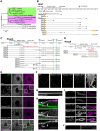
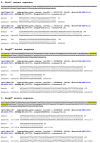


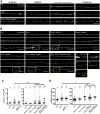

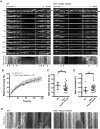
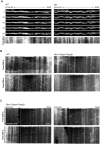
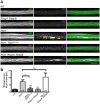
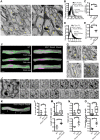


Similar articles
-
Reticulon-like-1, the Drosophila orthologue of the hereditary spastic paraplegia gene reticulon 2, is required for organization of endoplasmic reticulum and of distal motor axons.Hum Mol Genet. 2012 Aug 1;21(15):3356-65. doi: 10.1093/hmg/dds167. Epub 2012 Apr 27. Hum Mol Genet. 2012. PMID: 22543973 Free PMC article.
-
Mutations in the ER-shaping protein reticulon 2 cause the axon-degenerative disorder hereditary spastic paraplegia type 12.J Clin Invest. 2012 Feb;122(2):538-44. doi: 10.1172/JCI60560. Epub 2012 Jan 9. J Clin Invest. 2012. PMID: 22232211 Free PMC article.
-
Liver X receptor-agonist treatment rescues degeneration in a Drosophila model of hereditary spastic paraplegia.Acta Neuropathol Commun. 2022 Mar 28;10(1):40. doi: 10.1186/s40478-022-01343-6. Acta Neuropathol Commun. 2022. PMID: 35346366 Free PMC article.
-
Hereditary spastic paraplegia: clinico-pathologic features and emerging molecular mechanisms.Acta Neuropathol. 2013 Sep;126(3):307-28. doi: 10.1007/s00401-013-1115-8. Epub 2013 Jul 30. Acta Neuropathol. 2013. PMID: 23897027 Free PMC article. Review.
-
A complete overview of REEP1: old and new insights on its role in hereditary spastic paraplegia and neurodegeneration.Rev Neurosci. 2020 May 26;31(4):351-362. doi: 10.1515/revneuro-2019-0083. Rev Neurosci. 2020. PMID: 31913854 Review.
Cited by
-
Screening for REEP1 Mutations in 31 Chinese Hereditary Spastic Paraplegia Families.Front Neurol. 2020 Jun 23;11:499. doi: 10.3389/fneur.2020.00499. eCollection 2020. Front Neurol. 2020. PMID: 32655478 Free PMC article.
-
Hereditary Spastic Paraplegia and Future Therapeutic Directions: Beneficial Effects of Small Compounds Acting on Cellular Stress.Front Neurosci. 2021 May 6;15:660714. doi: 10.3389/fnins.2021.660714. eCollection 2021. Front Neurosci. 2021. PMID: 34025345 Free PMC article. Review.
-
Sphingolipids in neurodegenerative diseases.Front Neurosci. 2023 Feb 16;17:1137893. doi: 10.3389/fnins.2023.1137893. eCollection 2023. Front Neurosci. 2023. PMID: 36875645 Free PMC article. Review.
-
Neuronal maturation and axon regeneration: unfixing circuitry to enable repair.Nat Rev Neurosci. 2024 Oct;25(10):649-667. doi: 10.1038/s41583-024-00849-3. Epub 2024 Aug 20. Nat Rev Neurosci. 2024. PMID: 39164450 Review.
-
Navigating the neuronal recycling bin: Another look at huntingtin in coordinating autophagy.Autophagy Rep. 2025 Jun 2;4(1):2472450. doi: 10.1080/27694127.2025.2472450. eCollection 2025. Autophagy Rep. 2025. PMID: 40475846 Free PMC article. Review.
References
-
- Beetz C, Koch N, Khundadze M, Zimmer G, Nietzsche S, Hertel N, Huebner AK, Mumtaz R, Schweizer M, Dirren E, Karle KN, Irintchev A, Alvarez V, Redies C, Westermann M, Kurth I, Deufel T, Kessels MM, Qualmann B, Hübner CA. A spastic paraplegia mouse model reveals REEP1-dependent ER shaping. Journal of Clinical Investigation. 2013;123:4273–4282. doi: 10.1172/JCI65665. - DOI - PMC - PubMed
-
- Beetz C, Pieber TR, Hertel N, Schabhüttl M, Fischer C, Trajanoski S, Graf E, Keiner S, Kurth I, Wieland T, Varga RE, Timmerman V, Reilly MM, Strom TM, Auer-Grumbach M. Exome sequencing identifies a REEP1 mutation involved in distal hereditary motor neuropathy type V. The American Journal of Human Genetics. 2012;91:139–145. doi: 10.1016/j.ajhg.2012.05.007. - DOI - PMC - PubMed
-
- Ben-Yaakov K, Dagan SY, Segal-Ruder Y, Shalem O, Vuppalanchi D, Willis DE, Yudin D, Rishal I, Rother F, Bader M, Blesch A, Pilpel Y, Twiss JL, Fainzilber M. Axonal transcription factors signal retrogradely in lesioned peripheral nerve. The EMBO Journal. 2012;31:1350–1363. doi: 10.1038/emboj.2011.494. - DOI - PMC - PubMed
MeSH terms
Substances
Grants and funding
LinkOut - more resources
Full Text Sources
Other Literature Sources
Molecular Biology Databases
Research Materials

